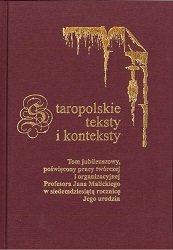„Wio Bury do góry”. Tajniki zbójeckiego rzemiosła w „Chronografii albo Dziejopisie żywieckim” Andrzeja Komonieckiego
„Wio Bury do góry“. The secrets of the bandit profession in „Chronography or the Chronicle of Żywiec” by Andrzej Komoniecki
Author(s): Beata Stuchlik-Surowiak
Subject(s): Language and Literature Studies, Studies of Literature, Public Administration, Polish Literature, Theory of Literature
Published by: Wydawnictwo Uniwersytetu Śląskiego
Keywords: Andrzej Komoniecki; banditry; Żywiec; chronicle
Summary/Abstract: The article discusses the issue of bandit activity in the Żywiec region in 17th and 18th century. The main source of information regarding that topic is „Chronography or the Chronicle of Żywiec” by Andrzej Komoniecki, which documented the history of Żywiec and its vicinity between 1400–1728. This singularly fascinating source text mentions a plethora of executions of local bandits, while the author does not shy away from detailed descriptions of torture and death penalty. The chronicle confirms that, due to the geographical location of Żywiec (the proximity of the mountains), bandit activity constituted a serious issues – hordes of bandits robbed houses, manors and parsonages, as well as traveling merchants, sparing no one who dared oppose them. On the other hand, many inhabitants of Żywiec assisted the bandits and – according to the sources – did so not only out of fear. On the contrary, the courage, resilience and lack of the fear of death that characterized the bandits made them more relatable to the rest of the populace. Those mechanisms, in turn, facilitated the emergence of the myth of the “noble bandit.”
- Page Range: 235-248
- Page Count: 14
- Publication Year: 2018
- Language: Polish
- Content File-PDF

